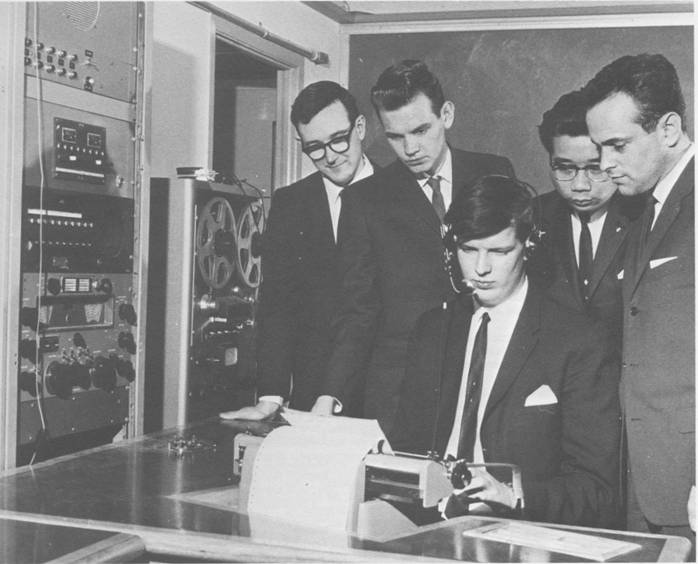
|
1967 New D.O.T. Course For Radio Operators
FIVE NEW OPERATORS Among the first 19 graduates of the D.O.T.'s new course for radio operators were, left to right, R. E. Gilroy, Burnaby, B.C., Eric Lange, Langley, B.C., and R. D. Thompson, Donald Mah and H. F. Wehner, all of Vancouver.
A new course has been added at the Department of Transport's Air Services School in Ottawa.
Designed to meet the Department's need for certified radio operators, the course has graduated its first class of 19 students and has three other classes totalling 90 students underway.
A unique feature is that it presents for the first time an opportunity for high school graduates to enter the Department directly and be trained with pay for a career in radio communications.
No longer does a young man have to spend one or two years at his own expense obtaining equivalent qualifications.
"We need 130 radio operators a year just to keep up with the demand," said A. A. Johnson, superintendent of the Air Services School.
The demand is high, he explained, because of the expanding needs of Canada's mushrooming air and water transport industry, in addition to the normal vacancies caused by promotion, retirement and resignation.
"To get 130 operators a year, we're attempting to recruit a class of 30 students to start the course every two months," Mr. Johnson said.
The course has been set up to provide operators for 163 D.O.T. radio stations across Canada which provide radio aids to marine and air navigation.
The stations range from bases at Montreal and Gander, which employ as many as 35 operators, to northern and coastal stations, some of which employ as few as two men. The course is taught by six radio operator instructors and two meteorological instructors (at some stations, the operator is required to take weather observations). Studies, consisting of roughly 50 per cent theoretical lectures and 50 per cent operational practice in carefully-simulated environments, are taught in three phases.
The first phase, basic electronics, also includes typing and Morse code. The second phase, meteorology, takes in instruction similar to that given weather observers. In the third phase, marine and aeradio operations, the students are instructed in radio aids to marine and air navigation.
The school where the course is taught (a modern brick building at 100 Dufferin Road in Ottawa which was converted for D.O.T. use) is equipped with an outside weather observation area, a teletype room with 16 machines, a typing and Morse code room and two operations rooms in which marine and air operations are simulated.
With a continuing drive for recruits, the Department is confident that it can meet the need for qualified radio operators. "I think we were fairly successful with the first class, said R. H. Bullbrook, the senior instructor of the course. "Of course, we're learning, too, and find that we're having more success with each new class."
The students, at present recruited by the D.O.T. from high schools in six regions across Canada, are paid $250 a month while in training and advance to $397 monthly on successful completion of the eight-month course and four months probation at operational stations.
Once the students graduate, they are posted to stations across Canada ranging from Fort Smith, Northwest Territories, to Grindstone in the Magdalen Islands.
|
|
Links - Liens
|






